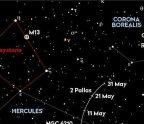CUTTING EDGE
Mar 25, 2021
4 minutes

Measuring Saturn’s twinkling rings
The light diffracting through the particles of Saturn’s rings helps astronomers measure their size

Diffraction is more often than not the bane of any observational astronomer’s life. This wave property of light means that light entering the aperture of a telescope spreads out slightly – just like water waves passing through the opening in a harbour wall. For an astronomer, diffraction acts to limit the maximum resolution that can be achieved with a telescope, and a point source like a star appears surrounded by a series of rings.
Exactly the same phenomenon also occurs when light waves pass and interact with a small particle. And it turns out that this effect can
You’re reading a preview, subscribe to read more.
Start your free 30 days





